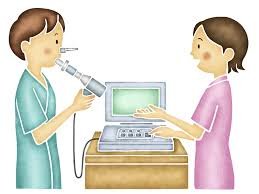healthcare

May 14,2025 • 5 min read
Pulmonary Function Test for Asthma – Purpose, Procedure & Results

Introduction
Asthma is a chronic respiratory condition affecting millions worldwide, characterized by airway inflammation, bronchoconstriction, and breathing difficulties. Accurate diagnosis and monitoring are essential for effective treatment, and one of the most reliable tools doctors use is the pulmonary function test (PFT) for asthma.
This comprehensive guide explores everything you need to know about PFTs—what they are, how they work, different types of tests, and why they are critical for asthma management.
What Is a Pulmonary Function Test (PFT)?
A pulmonary function test (PFT) is a non-invasive diagnostic procedure that measures how well your lungs work. It assesses lung volume, capacity, flow rates, and gas exchange, helping doctors diagnose and monitor respiratory conditions like asthma, COPD, and pulmonary fibrosis.
For asthma patients, PFTs are particularly valuable because they:
-
Confirm an asthma diagnosis
-
Determine the severity of airflow obstruction
-
Monitor disease progression
-
Evaluate treatment effectiveness
Types of Pulmonary Function Tests for Asthma
Several PFTs are used to evaluate asthma, each providing different insights into lung function.
1. Spirometry
Spirometry is the most common PFT for asthma. It measures how much air you can inhale and exhale and how quickly you can do so.
Key Measurements:
-
Forced Vital Capacity (FVC): Total air exhaled forcefully after a deep breath.
-
Forced Expiratory Volume in 1 Second (FEV1): Air exhaled in the first second of the test.
-
FEV1/FVC Ratio: A lower ratio indicates airway obstruction, a hallmark of asthma.
Bronchodilator Response Test:
If initial spirometry shows obstruction, a bronchodilator (like albuterol) is administered. Improved FEV1 (≥12% increase) suggests reversible airway obstruction, confirming asthma.
2. Peak Expiratory Flow (PEF) Test
A peak flow meter measures the maximum speed of exhalation. Asthma patients often use it at home to monitor daily lung function.
Uses:
-
Detects worsening asthma
-
Guides medication adjustments
3. Lung Volume Measurement (Body Plethysmography)
This test measures total lung capacity (TLC) and residual volume (RV). Asthma patients may have hyperinflation (increased TLC) due to air trapping.
4. Diffusing Capacity Test (DLCO)
Assesses how well oxygen passes from the lungs into the blood. While not diagnostic for asthma, it helps rule out other conditions like emphysema.
5. Methacholine Challenge Test
Used when asthma symptoms are unclear. Methacholine (a bronchoconstrictor) is inhaled—if FEV1 drops significantly, it indicates airway hyperresponsiveness, supporting an asthma diagnosis.
Why Is a Pulmonary Function Test Important for Asthma?
1. Accurate Diagnosis
Asthma symptoms (wheezing, coughing, shortness of breath) overlap with other conditions like COPD or vocal cord dysfunction. PFTs provide objective data to confirm asthma.
2. Assessing Severity
Based on FEV1 values, asthma severity is classified as:
-
Mild: FEV1 ≥ 80% predicted
-
Moderate: FEV1 60-79% predicted
-
Severe: FEV1 < 60% predicted
3. Monitoring Treatment Efficacy
Regular PFTs help doctors adjust medications (inhaled corticosteroids, bronchodilators) to ensure optimal asthma control.
4. Detecting Exacerbations
Declining PFT results may signal an impending asthma attack, allowing preemptive treatment.
What to Expect During a Pulmonary Function Test
Before the Test
-
Avoid smoking, caffeine, and heavy meals 4-6 hours prior.
-
Inform your doctor about recent illnesses or medication use.
During the Test
-
Spirometry: You’ll take a deep breath and blow forcefully into a tube.
-
Bronchodilator Test: If needed, you’ll inhale medication and repeat spirometry.
-
Lung Volume Test: You’ll sit in a sealed booth and breathe normally.
-
Methacholine Challenge: Gradual methacholine doses are inhaled, with spirometry after each dose.
After the Test
-
Results are compared to normal values based on age, sex, and height.
-
Your doctor will discuss findings and next steps.
Interpreting PFT Results for Asthma
| FEV1/FVC Ratio | ≥ 0.75-0.80 | < 0.70 suggests obstruction |
| FEV1 Improvement Post-Bronchodilator | < 12% | ≥ 12% indicates reversible obstruction (asthma) |
| Peak Expiratory Flow (PEF) | Varies by individual | Variability > 20% suggests asthma |
Limitations of Pulmonary Function Tests
-
False Negatives: Some asthma patients have normal PFTs between attacks.
-
Patient Effort: Results depend on proper technique.
-
Not a Standalone Test: Clinical history and other exams are also considered.
Frequently Asked Questions (FAQs)
1. How often should asthma patients get a PFT?
-
Initial diagnosis: At least once.
-
Severe asthma: Every 6-12 months.
-
Stable asthma: Every 1-2 years.
2. Are PFTs safe?
Yes, they are non-invasive. Rarely, a methacholine test may trigger mild bronchospasm, which is quickly reversed.
3. Can children undergo PFTs?
Yes, but they must be old enough (usually ≥5 years) to follow instructions.
4. Does insurance cover PFTs?
Most health plans cover PFTs if medically necessary. Check with your provider.
Conclusion
A pulmonary function test for asthma is a cornerstone of diagnosis and management, providing critical insights into lung health. Whether you’re undergoing spirometry, a methacholine challenge, or peak flow monitoring, these tests help tailor treatment for better asthma control.
If you experience persistent breathing difficulties, consult a pulmonologist or allergist for a comprehensive evaluation, including PFTs. Early diagnosis and proper monitoring can significantly improve your quality of life.
jonny Details
User Profile
- Full name
- jonny
- Email address
- tirthaclickssavvy@gmail.com
- Join Date
- 2025-05-14
- State
- City
- Pincode
- Address
- Follow us on Facebook
- Follow us on Twitter
- Website Name
- Bio